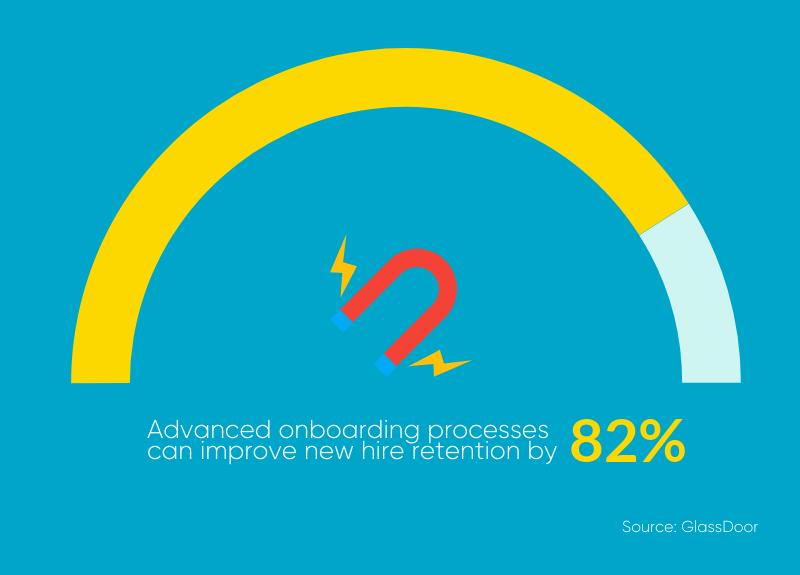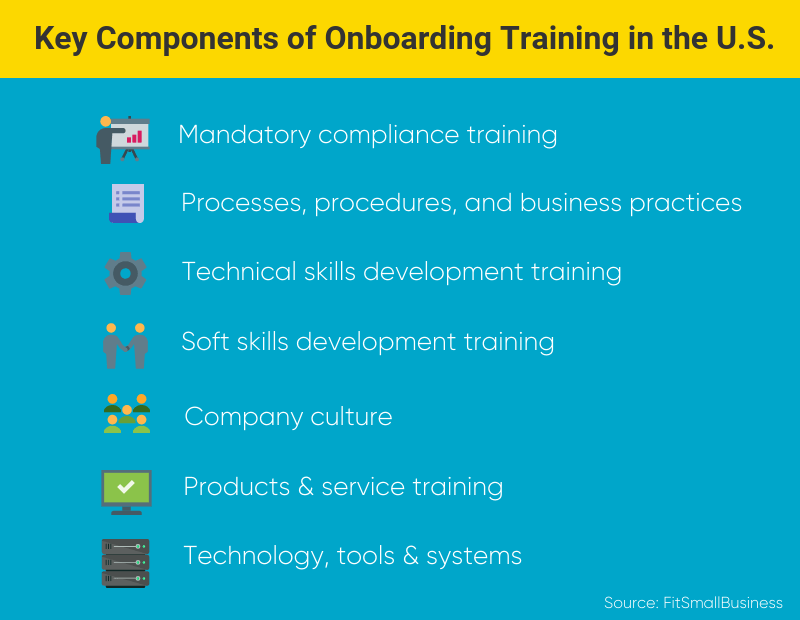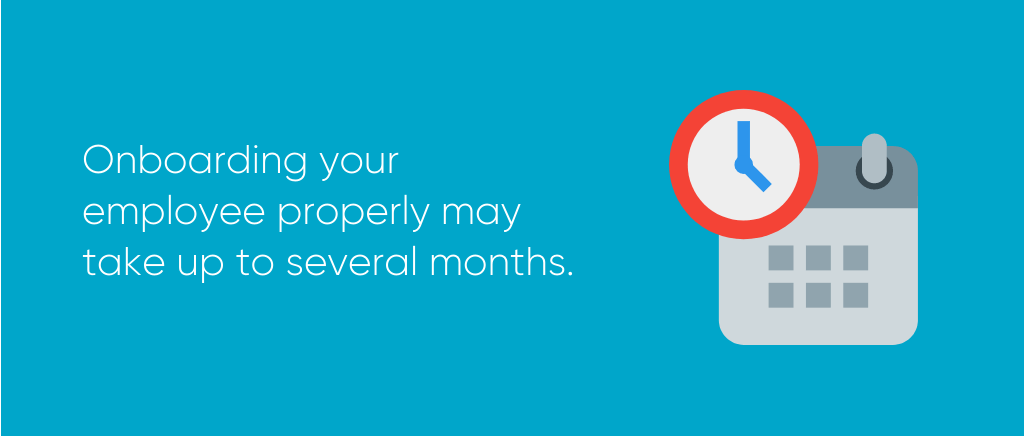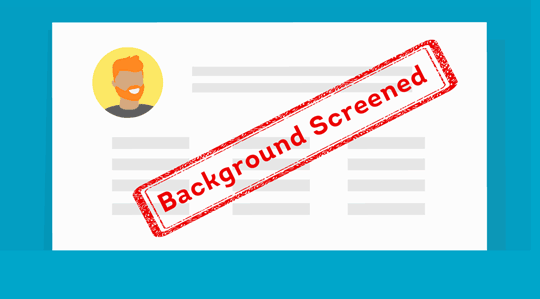Companies that are disorganized, unprepared, and inhospitable can have new hires running for the door—often within the first 90 days of employment. It takes time and effort, but onboarding new employees is an essential part of the hiring process—second only to running a pre-employment background check with ShareAble for Hires.
If you’re staring at your phone during a first date, chances are you won’t get a second. Likewise, employee onboarding is your opportunity to make a great first impression. If you blow it, you may send your new hire home thinking, “That place is a hot mess. What the heck have I gotten myself into”
According to a Glassdoor report, effective employee onboarding programs increase retention by 82% and boost productivity by 70%. On the other hand, companies that are disorganized, unprepared, and inhospitable can send new hires right back out your door—often within the first 90 days of employment.

*Trademarks mentioned in this blog are the property of their respective owners, and no affiliation or endorsement is implied.
Considering the high stakes of inadequate onboarding, it's worrying to learn that, according to Gallup, say their company provided sufficient onboarding. Some of the largest complaints are that the onboarding was primarily focused on paperwork, workspace, and materials where not ready, there were not opportunities to make connections with other people—and even that there was no onboarding program at all.
It takes time and effort, but onboarding new employees is an essential part of the hiring process—perhaps second only to running a comprehensive pre-employment background check. Onboarding isn’t just for establishing expectations, outlining qualities of a strong employee, and presenting company policies. It should also provide opportunities to assimilate into your company culture and boost a new hire’s confidence as they transition into their role.
This guide covers how to onboard new employees more efficiently and can help you create more engaging, effective employee onboarding programs that lead to longer-lasting work relationships.
What is Employee Onboarding?
Onboarding is the organized training and orientation process that companies provide to new hires in the initial days, weeks, and moths of employment. The Society for Human Resource Management* (SHRM) breaks down employee onboarding into three main objectives:
- Acclimation: A major factor for long-term success at an organization is an employee’s comfort level in their new work environment. Introducing your new employees to company culture, organizational values, and colleagues early on is incredibly beneficial to helping them feel like part of the team.
- Engagement: According to Gallup, companies with engaged workers see , 21% more productivity, and higher performance in customer ratings when compared to companies with low levels of engagement. SHRM says effective onboarding plans foster positive relationships between new hires and management.
- Retention: Providing new employees with the knowledge and resources they need to succeed in their job can help retain employees and improve their experience. Losing great employees can majorly sidetrack your progress. Even in your small business, costs from employee turnover can exceed tens of thousands of dollars.
From podcasts to instructional videos to on-the-job-teaching, how you decide to format your onboarding program is up to you. Just make sure it’s as engaging and informative as possible.
*Trademarks mentioned in this blog are the property of their respective owners, and no affiliation or endorsement is implied.
Is employee onboarding only for new hires?
Employers should consider doing employee onboarding for both new and existing employees. Ideally, employees go through orientation when they’re first hired. However, sometimes even longer-term employees may need additional training and onboarding, such as when:
- An employee started before an onboarding process was initiated
- Your organization changed the onboarding procedure since the employee was hired
- The employee received a promotion or changed positions within the organization
What should employee onboarding cover?
The specifics of your onboarding program depend on your company’s culture and objectives. That said, some general elements of employee onboarding include:

- Compliance and Safety Training
- Fire safety
- Sexual harassment training
- Workplace health and safety
- OSHA safety
- Processes and Procedures
- Employee manuals
- Company policies
- Benefits
- Time-off
- Human Resources introduction
- Technical Skills Development
- Job-specific training
- Soft Skills Training
- Team-building
- Communication training
- Company Culture
- How and when meetings occur
- Communication expectations
- Any regular events or socials
- Products and Services Training
- Demos
- Manuals and where to find help
- Technology, Tools, and Systems
- Computer set-up
- Introduction to project management systems
- Training on related technology
How long should employee onboarding last?
The length of your onboarding process depends on your organization and the complexity of the position. Ensure your employee can settle into their position and workplace with ongoing support throughout their tenure and not just for their first day or first week at work.
Consider these basic recommendations for onboarding new employees:
- Before you hire: Be transparent throughout the process. Post a clear, accurate job description, keep candidates updated throughout the recruiting process, and be professional when conducting interviews.
Confirm your candidate is just as glittering as their resume claims with a comprehensive employment background check through ShareAble for Hires. Save time with near-instant, online insights into a job applicant’s identity, credit history, and any relevant criminal background that could potentially endanger your livelihood. - When you make an offer: Present your initial offer over the phone followed by a written offer outlining details about the position, their start date, and how they can reach you in the meantime.
- Before their first day: Prepare all paperwork. Have a workstation, supplies, and equipment set up, connected, and ready to go. Create a schedule for your new hire. Including a primary onboarding session and HR meeting, any trainings, and opportunities to meet others on the team. Communicate first-day details—such as what documents to bring—to your new hire.
- On their first day: Introduce your new hire to the team, take them on an office tour, and review their first week’s itinerary. Conduct their initial onboarding meeting, which should include a review of company policies, information about benefits, instructions to request time-off, and an overview of the team culture and your company’s overall mission. Treat them to lunch with some of their colleagues.

- Within their first few months: Set goals to create structure and encourage motivation throughout your new hire’s first 90 days. Managers should hold regular one-on-one meetings to review progress and get a gauge on how the person is adjusting to the job and company as a whole. Finally, wrap up your onboarding process with an opportunity for both new hires and their managers to exchange feedback.
How weak onboarding programs harm your small business
Employee onboarding directly impacts profitability, productivity, and employee satisfaction. Good onboarding is so important that a bad process can be devastating for your company.
So, what makes an onboarding program bad?
According to SHRM, you should avoid these detrimental onboarding faux-pas:
- Managers or colleagues who don’t know how to conduct training or can’t answer vital questions
- Leaving new employees alone for lunch on day one
- Welcoming a new employee into an office space that’s messy or dysfunctional
- Giving the new employee a desk that’s not set up properly
- A manager that uses intimidation tactics rather than offering support
- Spending too much time on boring topics instead of engaging employees
Tips for Successful Employee Onboarding
1. Be prepared
As in dating, first impressions are everything. In the initial days and weeks, new hires are trying to discover where they fit in your organization. That’s why onboarding is critical to your company’s success. If employees don’t feel like they belong, they’re more likely to leave.
When your new employee(s) arrive on their first day, make sure to have all of the materials you need for training in order. This includes new hire documents, technology, equipment, and meeting spaces. In addition to preparing training items, you should also ensure that anyone that’s conducting onboarding is well-equipped with answers to common questions and that the trainee has a detailed itinerary to fill their time.
Showing your new hires that you’re ready for their arrival and determined to help them succeed can boost their first impression and position them for growth within your organization.
2. Present information in different ways
Whether it’s speaking a new language, solving a math equation, or figuring out a new job, everyone learns differently. To make onboarding more effective, consider how you present information and how new hires can absorb it in different formats, if necessary.
For visual learners, step-by-step training videos could be a good option; for those who prefer written directions, writing an employee manual could do the trick.
3. Involve multiple teams and people at different levels
Often, onboarding programs involve just a few team members. This makes it easy to pigeonhole new hires into one department, rather than giving them the opportunity to mix and mingle with other teams or executives.
By including executives and other departments in your onboarding process, you can:
- Empower new employees to learn about how the company works as a whole
- Encourage them to make broader connections
- Eliminate intimidations they might have with executives and upper management
4. Outline a path for professional development
So far, this article has presented employee onboarding as an opportunity to:
- Educate new employees on office protocol
- Train staff on job-specific duties
- Foster professional connections
- Improve retention and productivity
But, how does a strong onboarding program impact an employee’s long-term success? For one, a good program primes new employees for growth.
To facilitate retention right from the beginning, discuss goals during onboarding. Once you establish something specifically for new hires to work towards, schedule regular check-ins to review their progress and address anything that could impact how they’re adjusting to your company.
5. Be original to better retain
Your onboarding process doesn’t have to be all about company policies, paperwork, and processes. In fact, focusing only on these elements could actually hurt your small business.
Here are a few creative ways to onboard new employees:
- Incorporate team-building games and activities
- Hold an orientation session for a group of new hires
- Craft an onboarding kit with need-to-know information and company swag
- Partner new hires with a mentor or buddy for the first year of their employment
- Take your new employees out for a welcome lunch with key team members
- Have trainees do an art project related to your company’s values
- Create a checklist to ensure they meet their onboarding goals
- Give new staff a dictionary of terminology that’s specific to your organization or industry
- Have new employees complete a scavenger hunt to get them familiarized with the office space
- Post their photo and professional bio in the employee breakroom to introduce them to existing staff
6. Treat onboarding as a process, not an event
Onboarding should be viewed as a continuous process, not a single-day event. Think about it: if you tried to answer every new hire's question over the course of one workday or even their first week, you’d likely miss a few key points, and you’d certainly overwhelm your new team member with information.
Depending on the job and your company’s preferences, your onboarding process might last up to three months. This strategy facilitates strong connections, establishes a sense of transparency and support, and can ultimately improve the experience and tenure of new employees.

7. Delegate onboarding responsibilities
One of the main factors that prevents companies from implementing onboarding processes is budget. Yes, onboarding does require money and resources, but when compared to the cost of employee turnover, the money needed to onboard is a refreshing choice.
One way to combat money and resource-draining is by distributing onboarding and training responsibilities. When you have only one person providing all training, you take them away from their work. This limits productivity and narrows the new hire’s perspective down to just one source of information.
By delegating tasks among different staff members, you can get people back to work, while also improving the onboarding process for your new hire.
The “buddy system” is a popular method that organizations use to share training responsibilities and foster strong professional relationships between team members. This strategy partners the new hire with a veteran colleague to help them adjust to the new role. While their “buddy” might not join all the training sessions, they’re available to help ease the new employee’s transition.
8. Measure effectiveness and adjust
No matter how detailed the plans, it’s unlikely your training program will be flawless. The good news is you can lean on your initial program (and this guide) to help you adjust and improve as your staff and training systems grow.
An important part of improving the process is requesting feedback from everyone involved once the entire onboarding process is complete. Here are some ways you can gather information:
- Have new hires meet with their managers one-on-one to discuss the onboarding process
- Send out a survey to all recent hires asking them to rate certain parts of the program, and ask them for feedback and suggestions
- Conduct an open forum meeting for recent hires to ask additional training questions and discuss onboarding processes
Use the information you collect to tailor and improve your onboarding program for future hires. Employers should also keep in mind that your new hires aren’t robots, so it’s unlikely that they’ll absorb everything right away. Always be prepared to review questions and information over the first few months of the new hire’s employment.
Before Good Onboarding, Screen Out the Wrong Applicants
Despite so many advantages, some companies are dangerously behind the curve on employee onboarding. It’s crucial for employers to create robust onboarding, but it’s even more critical to attract top-quality talent in the first place. After all, investing effort and resources into a great onboarding plan is useless if you hire an ill-fitting candidate that leaves—or, worse, you have to fire—within the first few months.
Don’t waste your precious time and money onboarding potentially destructive hires. Thoroughly screen all job finalists with lightning-fast online background checks from ShareAble for Hires. Designed specifically for small businesses, you can get quick, easy-to-read reports about a job candidate’s history and record.
Find out if your new hire has multiple relevant convictions or a fraud-laden credit record before letting them in the building for training. A criminal background check scours millions of federal and state-level records, searching for your candidate’s biographical information. Detailed employee credit checks can help you determine if your job candidate has a troubling financial history that could mean ruin for your business.
With FCRA-compliant data sourced through TransUnion, a major credit agency, you get more trustworthy reports and the information you need to make hiring decisions.
Like with dating, long-term employee success comes from giving your full attention to your new hire. When you start your hiring process with better screening, you start your onboarding process with better employees. Help set your work relationship up for success with ShareAble for Hires.
ShareAble for Hires
Sign-up Now. Reports Now. Hire Now.
*Trademarks mentioned in this blog are the property of their respective owners, and no affiliation or endorsement is implied.







